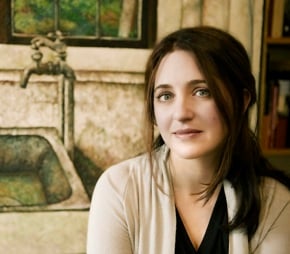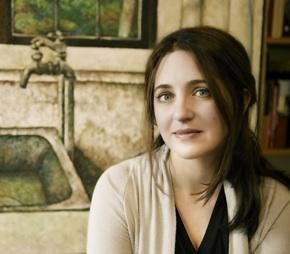
Photo by Lisa Marie Mazzucco
Pianist Simone Dinnerstein has already defied the odds. After spending her early career in non-stardom, the Brooklyn native was approaching her mid-30s when her self-produced recording of Bach’s Goldberg Variations captivated Philadelphia Inquirer critic David Patrick Stearns, who passed it on it Robert Woods, former president of Telarc Records. Hooked by Dinnerstein’s heartfelt and idiosyncratic approach, Woods released Dinnerstein’s Goldberg recording in both CD and iTunes download formats in 2007.
Bach and Dinnerstein immediately went viral. A week after the recording’s release, she went from soliciting funds to No. 1 on the US Billboard classical chart.
Just as her second all-Bach recording, Bach: A Strange Beauty, becomes available worldwide, Dinnerstein is setting out to explore new territory. On Jan. 31, she and singer-songwriter Tift Merritt will appear at Yoshi’s San Francisco in an unusual musical collaboration titled Night. Although Bach will no doubt find his way onto a program that includes songs by Brad Mehldau, Patty Griffin, Philip Lasser, Jenny Scheinman, Merritt, and some classical giants, the evening will be far from classical.
SFCV caught up with Dinnerstein by phone on Jan. 14, as she was readying herself for the next chapter of her career.
You’d been performing in New York City and around the country for some time before your big breakthrough in 2007. What exactly had you been doing?
I think my career was pretty typical of a freelance musician. I did quite a lot of recitals. I played a lot of recitals for the Piatigorsky Foundation. They would send me on tours around the U.S. playing in small towns in non-traditional venues.
The tours would fulfill their mission to bring music to places that wouldn’t ordinarily have classical music concerts. I did concerts in retirement communities, schools, libraries, community centers, churches, synagogues … I even did a concert in a prison and for a foster home for kids. They were pretty unusual places, and I got to see a lot of parts of the United States that I wouldn’t have seen elsewhere.
The most difficult places I’ve had to play are cancer treatment centers. The one I found most difficult was a children’s wing of a cancer center. It’s really important to play concerts in places like that, because it’s very meaningful for the people there.
I also did a lot of chamber music and collaborative playing, and a fair amount of teaching.
Listen To The Music
Buy Tickets
KDFC presents Tift Merritt and Simone Dinnerstein
Venue: Yoshi'sCity: San Francisco
Date: January 31, 2011 8:00 PM
Price Range: $30
Related Articles
Simone Dinnerstein's “Strange” Bach
January 31, 2011
Bailey and Dinnerstein Fearlessly Deliver Five-Alarm Beethoven
August 25, 2009
What were your expectations when you first recorded the Goldberg Variations?
When I recorded the piece, I didn’t have any expectations as to what the practical uses of the recording would be. I made the recording because I felt artistically it was the right time. I had been performing the piece, and I felt I really had something to say about it. I wanted to document how I was playing it then.
Once it was recorded and I started getting a really positive response from different people, I started to hope that it would be released commercially and reach many more people than I was capable of reaching just on my own.
Were you surprised by the reaction?
Oh yes. It was completely stunning, very unusual, and completely unexpected.
Your new recording is on Sony. When I think of Sony, I can’t help thinking of Joshua Bell and “crossover.” And here you are, about to perform with Tift Merritt, if we can even call that crossover. Is there pressure from Sony to do those kinds of projects? What do you plan, going on, with Sony?
We haven’t discussed any crossover projects. This project with Tift was arranged before I had a relationship with Sony.
Tift and I both admire each other’s work and felt that we had certain things in common that would be interesting to explore. I’m real excited about our collaboration. I don’t think “crossover” would be the right word for what we’re doing. I don’t even know the word. I don’t think “fusion” is the right word either.
Basically, we’ve put together a program that combines art songs from the classical repertoire, pop songs, Tift’s own songs, and some solo piano music of mine. We’ve also commissioned a few composers to write songs for us. We’re doing sets of songs where we establish relationships between different songs from different genres.
What art songs?
I have to be a little mysterious about this, because Tift never gives away her set list. That’s very different from how I’m used to doing things, because I have to submit programs two years in advance. So I don’t know exactly how much to say in advance.
I guess I can give you some composers we’re going to be doing. The classical composers are Schubert, Fauré, and Purcell.
Tift doesn’t sound anything like Barbra Streisand, so it’s not going to be Classical Tift.
No, no. We’re not doing it in a classical style. We’re doing the songs in a way that feels authentic to the way that Tift would sing them. I’ve had a lot of ideas about this, as has she, but we’ve changed things about the songs. It’s not her trying to be classical. It’s her interpreting these songs, which I think is what music should be. That’s why we’re interpreters [laughing].
Do you have plans to record your program?
I’m hoping to get archival recordings to listen to. This is obviously a project that is developing. But I think this would be an interesting recording. We’ve been talking about it amongst ourselves, but we have no formal plans. We haven’t talked to any of the record labels.
What will you be playing?
I’m going to be equally coy about what I’m playing.
I don’t know if Tift is a good or bad influence on you.
I really like this approach. I think this is how all concerts should be. You just come, and then you find out what the person’s playing.
Tift and I have been talking about giving out a program that you’d get right before you leave the concert, so that you can remember what it was. But it wouldn’t be something you could follow as it goes along.
What do you love about Tift’s music?
Most importantly, she has real soul in her singing. I love her songs that she’s written, because I think they’re very intimate and personal and lyrical. But her phrasing also has an interesting sense of rhythm. It’s not square at all. Often I find a lot of pop music and singer/songwriters to be a little bit square and slightly predictable. I don’t find that about her at all.
Seeing her perform live is extremely exciting, because she has so much energy in her interpretations. She uses her whole body and her boots are adding a whole rhythm section to what she’s doing. It’s very moving.
How did you two meet?
I met her because she was going to interview me for Gramophone magazine. She also interviewed me at the same time for a radio show that she does in Marfa, Texas. Since I knew that she was going to be interviewing me, I got her CDs and listened to them.
I was performing at Le Poisson Rouge, a club in Greenwich Village. She came there, and also listened to my recordings. Then we met up and had this very long, in-depth interview. We really liked each other and felt we had a lot in common. So we became friends.
Then we started thinking about how it would be really interesting to try to do something together. So it became a long process trying to figure out how we would do that, and what it’s nature would be.
I feel so excited with what’s happened. We spent the last week of December rehearsing very intensively. It was so exciting. I haven’t had that much fun ... it felt so creative; I hadn’t felt like that in a really long time.
Wonderful. Please tell us about the new Bach album, and the thinking that led to your choice of repertoire.
I wanted to play an assortment of music by Bach that would show the different sides of his writing. I thought it would be interesting to have a theme of music that he wrote and then reused in different ways.
The chorale preludes I recorded started off [in] cantatas. Then Bach made these organ improvisations from the chorales. Then pianists from the early 20th century took those organ improvisations and turned them into piano pieces. So the three chorales I recorded, in arrangements by Busoni, Kempff, and Hess, are kind of twice removed from the originals.
The concertos I recorded, Nos. 1 and 5, were both used in cantatas later on, as well as being used as concertos for other instruments. And the centerpiece of the recording, the English Suite No. 3, has a first movement that is written in the style of the concerto grosso. Even though it’s written for keyboard, it’s written as if it was for a whole string orchestra. I thought it would be interesting to juxtapose those different works next to each other.
Have you experimented with playing his music on an instrument more of his time?
I’ve played on a harpsichord. I haven’t played on a clavichord, which I would really be interested in trying. But I love the modern piano. I personally like the sound of Bach on it more than on any of the original instruments.
Do you have a favorite piano? Does one work better than the other for you?
Well, I actually just bought — a month ago it arrived — one of the most beautiful pianos I’ve ever played on. I discovered the instrument when I recorded the Bach CD on it. It’s the 5-year-old Hamburg Steinway concert grand that I recorded on in Berlin.
I had chosen it for the recording. During the recording sessions, I fell in love with it. I couldn’t believe what a gorgeous instrument it was. Then I found out it was for sale, and I figured out a way of buying it.
What were you playing before?
Actually, different people were lending me pianos that I played at home. My parents had bought me a Baldwin grand when I was 9. They still have it in their home. That piano had been in a nightclub in New York, and had been used in the production of Ain’t Misbehavin’ where Hank Jones played it every week.
Then the club was closed and the building was going to be knocked down. They auctioned off the piano, and my parents bought it. It’s the piano I grew up playing on, but I kind of outgrew it. Then I had people lend me pianos. So it’s kind of great to finally own… I never thought I would own an instrument that is as amazing as the one I have now.
Back to your forthcoming performance. Have you done other collaborations with pop or jazz performers?
No, I’ve never done anything like this. And I don’t think Tift has either. It’s very exciting.
Both our fears were that we were somehow going to compromise ourselves or lose something of ourselves in trying to get together. In fact, I feel we’ve gained so much. It’s turned into something so different and unusual, and really creative. I feel we’ve been very true to ourselves musically while doing this, and that’s the thing we really wanted to achieve. I hope it goes over that way. But that’s how we feel about it.

